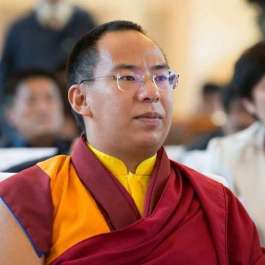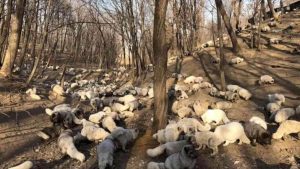In May 2024, I delivered a presentation to the Swedish Bhutan Society and assembled friends in dance, anthropology, museum exhibition, ethnographic research, remote exploration, and the fine arts. The talk, “Mystical Dances in the Kingdom of Bhutan,” was in three parts. Part 1 appeared in BDG in September. Part 2 appeared in November, and the concluding Part 3 is presented here. Portions of this article are taken from my upcoming book, Buddhist Dances, Movement & Mind (Motilal Banarsidass, 2025).

Treasure-revealers
Buddhist visionaries who established dance traditions created a culture across time and landscape that is unique—the cult of the treasure-revealers. This culture is most closely associated with the Nyingma order of Vajrayana Buddhism and its mystic founder Guru Rinpoche. There is a parallel with dance arising from meditation in the Islamic Sufi tradition of the Mevlevi Order.
The story goes that after Guru Rinpoche ended his earthly life by dissolving into light, his disciplines went on to teach Buddhism. When these disciples reincarnated centuries later, they would discover treasures left for them by Guru Rinpoche and then they would reveal the mystic treasures, hence the term treasure-revealers. Treasure-revealers are reincarnated early disciples sharing teachings from Guru Rinpoche designed to be revealed at a later time.

The treasure-revealers are mystic visionaries called terton in Tibetan. The treasures are called terma. The discoveries and their revelation came in myriad forms: as texts appearing in visions, as objects found in the natural world; as canons of spiritual practices; as directions for how to make a set of paintings.
Some terton—after their visions—unlock coded symbolic language or images to decipher a dance. Sometimes the dance ultimately takes the form of a chams yig, or dance manual that can contain a wide range of detail. In visions and lucid dream-states, dances of substantial duration, more than an hour, are apprehended at once, outside of time. This capacity of consciousness is something long developed in Bhutan and the Himalayas. Far from extraordinary, this mystical genesis of choreography is a well-known, even prevalent tradition of yogic mastery. There are, consequently, many forms of “revealed” dance or dances born in a synesthetic meditation experience.

Often the terton reveals something that must then be interpreted by him. Sometimes, the treasures were discovered in the mind. And sometimes, the mystic treasure is a dance, a big dance, with lots of dancers in animal masks and complex choreography. Sometimes, it is a metaphysical dance by enlightened beings. Usually, the vision is a mandala dance—a dance that plays out on a mandala structure. Mandalas are a standard device in tantric visualization meditation. A treasure dance is called a tercham. There are many treasure dances extant in Bhutan, and many more across the Buddhist landscape. Their geographic range and longevity are noteworthy. Many of these transmitted dance traditions, some more than 600 years old, are in robust shape.

The West does not have such a visionary genesis of choreography as a tradition spanning centuries and in evidence today. According to the accounts of treasure-revealers, one traditional means of learning a dance in a vision is this: a yogi meditates and has a vision, often traveling to Guru Rinpoche’s otherworldly palace of light, Zangdok Palri, where there is always dancing. Even the beings in the sky around Zangdok Palri dance. Zangdok Palri is considered a tantric form of Guru Rinpoche and so actually the Guru himself. Zangdok Palri is a generator of dances.

Once arriving in Zangdok Palri by ecstatic journey, the yogi watches a dance, or is taught a dance by a dakini, or by Guru Rinpoche’s consort Yeshe Tsogyal, who taught a number of treasure-revealers different treasure dances. There are detailed written accounts of some of these visions. One such journey, and Zangdo Palri dance experience, by Chokgyur Lingpa is depicted in a mural in Bhutan.
The next translation, or transmutation of the meditative vision is fascinating regarding these dances: how is the physical dance then taught to others as a viable piece of choreography? It is a change of dimension from a yogi’s vision to a dance for 12 monks, which survives 600 years and has original costumes with animal masks also derived from the vision. I’d never before encountered a large circular masked dance explained this way to me. It was a new type of dance phenomenon for me to appreciate. I had so many questions: for instance, what exactly happened in the visionary meditative experiences? And what could produce a viable dance?

One Bhutanese treasure dance is three hours long! Was it a three-hour vision, or a dance outside of time, learned outside of time, and then taught in time? The dances are made of complex number sequences, interlocking patterns of circular movement, algorithms, really, and often gyroscopic aerial choreography. There is an exorcistic sacrificial rite within the dance, the ritual slaying of evil. The mechanism and reflex of the treasure-revealer finding something planted for him in the eighth century is already outside of time.

The lasting power of the dances is a defining characteristic. The local religious explanation for the dances’ mystical origin is something to respect on seeing that the dances are spiritual techniques in themselves. The dances are borne by a spiritual power in a visceral, original sense.
The story of a visionary trip to Zangdok Palri resulting in a dance is often encountered as an origin story for this type of religious dance. There are many other types of mystically derived dances within the treasure-revealer traditions. The widespread phenomena of treasure dances deserve more research.
The Nyingma order of Vajrayana Buddhism is strong in Bhutan and connected to old local families and stories about Padmasambhava. The Nyingma tradition of treasure-revealers is also strong there and has given the modern world intact examples of visionary dance. A mystical feat, such as bringing a dance out of a vision, is the basis for some of the oldest dances in Bhutan.

See more
Related features from BDG
Mystical Dances in the Kingdom of Bhutan, Part 1: A Black Magic Dance at the Core of Bhutan’s Founding
Mystical Dances in the Kingdom of Bhutan, Part 2: Cham is Deity Yoga in Action














